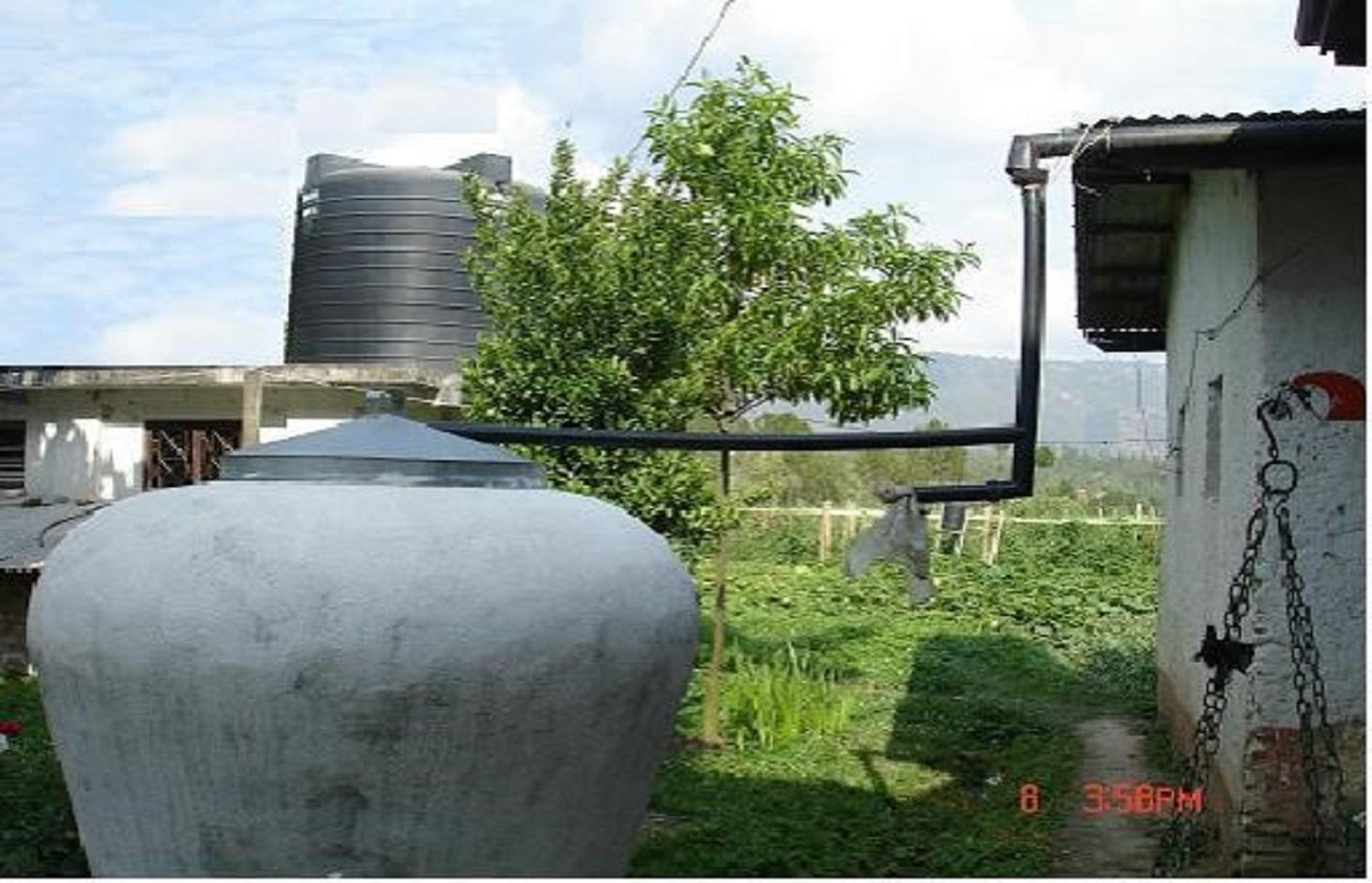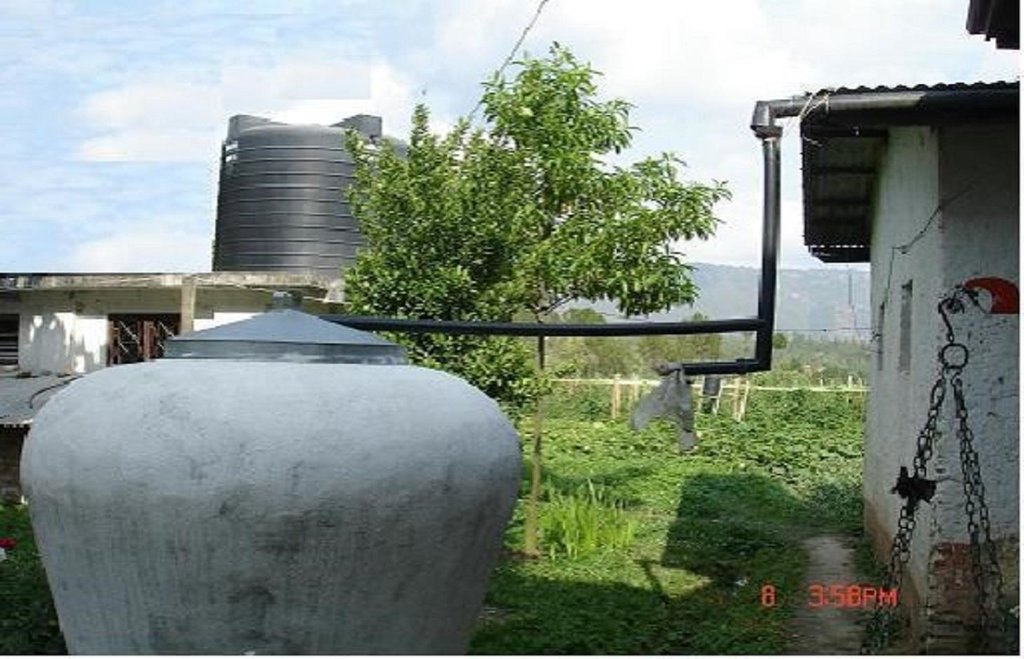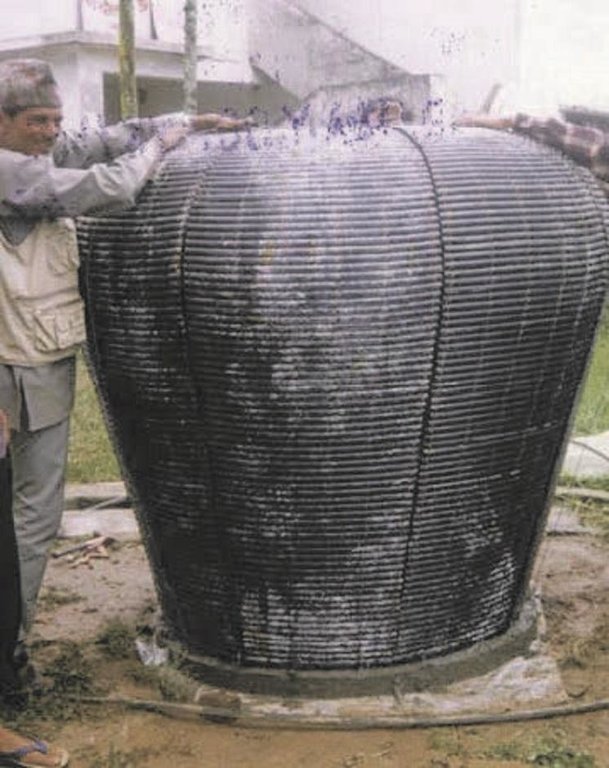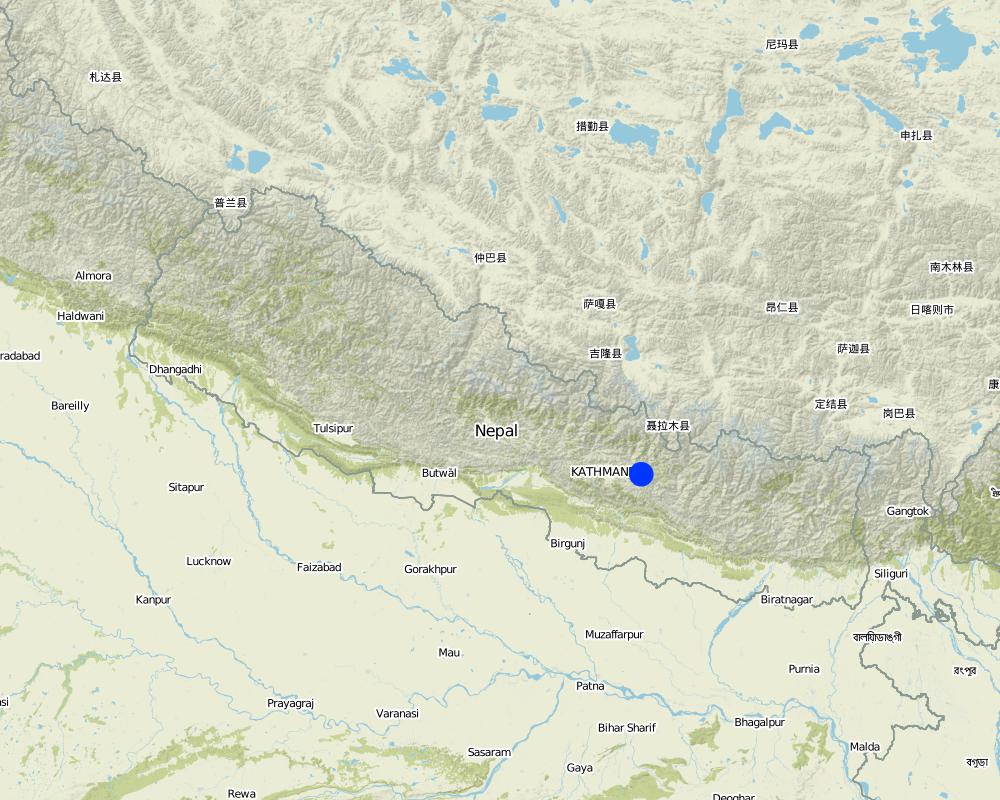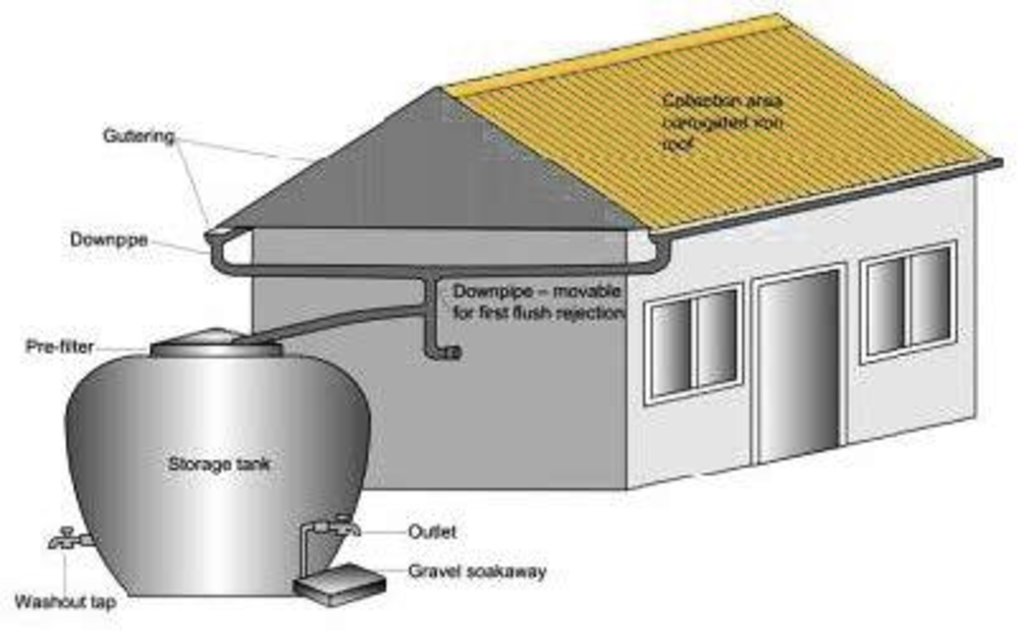Rooftop rainwater harvesting system [ເນໂປ]
- ການສ້າງ:
- ປັບປູງ:
- ຜູ້ສັງລວມຂໍ້ມູນ: Madhav Dhakal
- ບັນນາທິການ: –
- ຜູ້ທົບທວນຄືນ: David Streiff, Deborah Niggli, Alexandra Gavilano
Akase paani sankalan pranali - Nepali
technologies_1497 - ເນໂປ
ເບິ່ງພາກສ່ວນ
ຂະຫຍາຍທັງໝົດ ຍຸບທັງໝົດ1. ຂໍ້ມູນທົ່ວໄປ
1.2 ຂໍ້ມູນ ການຕິດຕໍ່ພົວພັນ ຂອງບຸກຄົນທີ່ສໍາຄັນ ແລະ ສະຖາບັນ ທີ່ມີສ່ວນຮ່ວມ ໃນການປະເມີນເອກກະສານ ເຕັກໂນໂລຢີ
ຜຸ້ຊ່ຽວຊານ ດ້ານການຄຸ້ມຄອງ ທີ່ດິນແບບຍືນຍົງ:
ຜຸ້ຊ່ຽວຊານ ດ້ານການຄຸ້ມຄອງ ທີ່ດິນແບບຍືນຍົງ:
ຊື່ໂຄງການ ທີ່ອໍານວຍຄວາມສະດວກ ໃນການສ້າງເອກກະສານ/ປະເມີນ ເຕັກໂນໂລຢີ (ຖ້າກ່ຽວຂ້ອງ)
Book project: Water Harvesting – Guidelines to Good Practice (Water Harvesting)ຊື່ສະຖາບັນ (ຫຼາຍສະຖາບັນ) ທີ່ອໍານວຍຄວາມສະດວກ ໃນການສ້າງເອກກະສານ / ປະເມີນ ເຕັກໂນໂລຢີ (ຖ້າກ່ຽວຂ້ອງ)
ICIMOD International Centre for Integrated Mountain Development (ICIMOD) - ເນໂປ1.3 ເງື່ອນໄຂ ກ່ຽວກັບ ການນໍາໃຊ້ຂໍ້ມູນເອກະສານ ທີ່ສ້າງຂື້ນ ໂດຍຜ່ານ ອົງການພາບລວມຂອງໂລກ ທາງດ້ານແນວທາງ ແລະ ເຕັກໂນໂລຢີ ຂອງການອານຸລັກ ທໍາມະຊາດ (WOCAT)
ຜູ້ປ້ອນຂໍ້ມູນ ແລະ ບຸກຄົນສຳຄັນ ທີ່ໃຫ້ຂໍ້ມູນ (ຫຼາຍ) ຍິນຍອມ ຕາມເງື່ອນໄຂ ໃນການນຳໃຊ້ຂໍ້ມູນ ເພື່ອສ້າງເປັນເອກກະສານຂອງ WOCAT:
ແມ່ນ
2. ການອະທິບາຍ ເຕັກໂນໂລຢີ ຂອງການຄຸ້ມຄອງ ທີ່ດິນແບບຍືນຍົງ
2.1 ຄໍາອະທິບາຍສັ້ນຂອງ ເຕັກໂນໂລຢີ
ການກຳໜົດຄວາມໝາຍ ຂອງເຕັກໂນໂລຢີ:
A water harvesting system in which rain falling on a roof is led through connecting pipes into a ferro-cement water collecting jar.
2.2 ການອະທິບາຍ ລາຍລະອຽດ ຂອງເຕັກໂນໂລຢີ
ການພັນລະນາ:
Many households in Nepal’s midhills suffer from water shortages during the pronounced dry season. The technology described here - harvesting roofwater during times of heavy rainfall for later use - is a promising way of improving people’s access to water for household use, especially for households with no or only limited access to spring or stream water. The technology has yet to be extensively adopted in Nepal’s midhills.
Purpose of the Technology: The technology was introduced in the Jhikhu Khola watershed to demonstrate an alternative source of water for domestic use (mainly drinking water). This technology is appropriate for scattered rural households in mountaineous areas. The harvesting system consists of a catchment roof, conveyance pipes, and a storage jar. The pipes include a gutter system made from longitudinally split polythene pipe which has a flushing system that allows the system to be periodically flushed clean.
The collected water enters a 500 or 2000 litre capacity ferro-cement jar made using a mould (see photo). A preconstructed mould made from iron rods and polythene pipes is installed on a concrete base plate. Metal wires are extended from the base plate over the main mould to the top. Chicken mesh is then wrapped over the mould and tied securely with thin wire. A cement coating is applied over the metal structure. The jar is finished with three coatings of cement and the opening is covered with a fine nylon mesh to filter out undesired coarse matter. A tin lid is placed over the top.
Establishment / maintenance activities and inputs: A tap is fixed about 20 cm above the ground. This height allows for water to be collected in the typical 15 litre local water vessels (gagri) and avoids collection of too much water in bigger vessels as well as minimising the dead storage of water (Nakarmi et al. 2003). Trained masons can easily install the entire system. Provided all the materials and the mould are available, the entire system can be put together in about a week. The main maintenance task is to keep the roof clean, especially after long dry periods. This is done using the gutter pipe flushing system in which the first dirty water from the roof is diverted away from the jar.
2.3 ຮູບພາບຂອງເຕັກໂນໂລຢີ
2.5 ປະເທດ / ເຂດ / ສະຖານທີ່ບ່ອນທີ່ ເຕັກໂນໂລຢີ ໄດ້ຮັບການນໍາໃຊ້ ແລະ ທີ່ຖືກປົກຄຸມດ້ວຍການປະເມີນຜົນ
ປະເທດ:
ເນໂປ
ພາກພື້ນ / ລັດ / ແຂວງ:
Kharelthok, Sathighar, Panchkhal, Hokse and Patalekhet VDCs of the Jhikhu Khola watershed
ຂໍ້ມູນເພີ່ມເຕີມຂອງສະຖານທີ່:
Kavrepalanchowk district
ໃຫ້ລະບຸ ການແຜ່ຂະຫຍາຍ ເຕັກໂນໂລຢີ:
- ນໍາໃຊ້ໃນຈຸດສະເພາະ / ແນໃສ່ນໍາໃຊ້ໃນພື້ນທີ່ຂະໜາດນ້ອຍ
ຄວາມຄິດເຫັນ:
Roof rainwater harvesting jars were demonstrated mostly in the villages located at the watershed divides, hilltops, and elevated terraces where communities face chronic water shortage particularly during the dry period.
Map
×2.6 ວັນທີໃນການຈັດຕັ້ງປະຕິບັດ
ຖ້າຫາກວ່າ ບໍ່ຮູ້ຈັກ ປີທີ່ຊັດເຈນ ແມ່ນໃຫ້ປະມານ ວັນທີເອົາ:
- ຕໍ່າກວ່າ 10 ປີ ຜ່ານມາ (ມາເຖິງປະຈຸບັນ)
2.7 ການນໍາສະເໜີ ເຕັກໂນໂລຢີ
ໃຫ້ລະບຸ ເຕັກໂນໂລຢີ ໄດ້ຖືກຈັດຕັ້ງປະຕິບັດຄືແນວໃດ?
- ໂດຍຜ່ານໂຄງການ / ການຊ່ວຍເຫຼືອຈາກພາຍນອກ
ຄວາມຄິດເຫັນ (ປະເພດ ໂຄງການ ແລະ ອື່ນໆ):
Water harvesting is an ancient practice, the system used in the Jhikhu Khola watershed came from Thailand, so the technology is often called 'Thai jar". In Nepal, the Rural Water Supply and Sanitation Support Programme (RWSSSP), which is jointly funded by the Government of Finland and His Majesties Government of Nepal, introduced it in the water deficit districts of western Nepal (Arghakhanchi, Gulmi, Kapilvastu, Nawalparasi, Palpa, Parbat, and Rupandehi).
3. ການໃຈ້ແຍກ ເຕັກໂນໂລຢີ ໃນການຄຸ້ມຄອງ ດິນແບບຍືນຍົງ
3.1 ຈຸດປະສົງຫຼັກ (ຫຼາຍ) ຂອງເຕັກໂນໂລຢີ
- Access to water
3.2 ປະເພດການນໍາໃຊ້ທີ່ດິນ ໃນປະຈຸບັນ() ທີ່ເຕັກໂນໂລຢີ ໄດ້ຖືກນໍາໃຊ້

ການຕັ້ງຖິ່ນຖານ, ພື້ນຖານໂຄງລ່າງ
- ການຕັ້ງຖິ່ນຖານ, ອາຄານ
ຂໍ້ສັງເກດ:
courtyard
ຄວາມຄິດເຫັນ:
Major land use problems (compiler’s opinion): Inadequate water supply during the late winter and pre-monsoon months and sediment contamination during the wet season. The discharge from traditional water sources like dug-out ponds, springs, seepage ‘holes’, shallow wells and streamlets becomes limited soon after the end of the monsoon.
Major land use problems (land users’ perception): Many settlements are located on ridge tops and most water sources are located below making it difficult to provide water to households through networks of pipes. Women and girls often face hardship in carrying the water uphill, especially during the monsoon when trails are slippery.
Constraints of settlement / urban
Number of growing seasons per year: 3
Longest growing period in days: 150; Longest growing period from month to month: Jun - Oct; Second longest growing period in days: 120; Second longest growing period from month to month: Nov - Feb
3.5 ການນໍາໃຊ້ເຕັກໂນໂລຢີ ທີ່ຢູ່ໃນກຸ່ມການຄຸ້ມຄອງ ທີ່ດິນແບບຍືນຍົງ
- ການເກັບກັກນໍ້າ
3.6 ມາດຕະການ ການຄຸ້ມຄອງ ທີ່ດິນແບບຍືນຍົງ ປະກອບດ້ວຍ ເຕັກໂນໂລຢີ

ມາດຕະການໂຄງສ້າງ
- S5: ເຂື່ອນໄຟຟ້າ, ຝາຍເກັບນໍ້າ, ອ່າງ, ໜອງ
3.7 ປະເພດດິນເຊື່ອມໂຊມ ຫຼັກທີ່ໄດ້ນໍາໃຊ້ ເຕັກໂນໂລຢີ

ການເຊື່ອມໂຊມ ຂອງດິນ ທາງກາຍະພາບ
- ນ້ຳຂັງ
ຄວາມຄິດເຫັນ:
Main causes of degradation: change of seasonal rainfall
3.8 ການປ້ອງກັນ, ການຫຼຸດຜ່ອນ, ຫຼືການຟື້ນຟູຂອງການເຊື່ອມໂຊມຂອງດິນ
ໃຫ້ລະບຸ ເປົ້າໝາຍ ເຕັກໂນໂລຢີ ທີ່ພົວພັນ ກັບຄວາມເຊື່ອມໂຊມຂອງດິນ:
- ຫຼຸດຜ່ອນການເຊື່ອມໂຊມຂອງດິນ
4. ຂໍ້ກໍາໜົດ, ກິດຈະກໍາການປະຕິບັດ, ວັດຖຸດິບ, ແລະຄ່າໃຊ້ຈ່າຍ
4.1 ເຕັກນິກ ໃນການແຕ້ມແຜນວາດ ເຕັກໂນໂລຢີ
ຄຸນລັກສະນະ ຂອງເຕັກນິກ (ທີ່ກ່ຽວຂ້ອງ ກັບການແຕ້ມແຜນວາດ ທາງດ້ານເຕັກນີກ):
A water harvesting system with roof catchment, connecting pipes and storage tank.
Technical knowledge required for field staff / advisors: high
Technical knowledge required for land users: high
Main technical functions: water harvesting / increase water supply
Structural measure: Dam/ pan/ pond
Material: Concrete
Structural measure: Jar
Structural measure: Gutter
Structural measure: pipes
Construction material (other): Cement
ຜູ້ຂຽນ:
A.K. Thaku
4.2 ຂໍ້ມູນທົ່ວໄປກ່ຽວກັບການຄິດໄລ່ປັດໃຈຂາເຂົ້າໃນການຜະລິດ ແລະ ມູນຄ່າອື່ນໆ
ລະບຸ ວິທີການ ຄຳໃຊ້ຈ່າຍ ແລະ ປັດໄຈນໍາເຂົ້າ ທີ່ໄດ້ຄິດໄລ່:
- ຕໍ່ຫົວໜ່ວຍ ທີ່ໄດ້ຈັດຕັ້ງປະຕິບັດ ເຕັກໂນໂລຢີ
ໃຫ້ລະບຸຫົວໜ່ວຍ:
Rooftop rainwater harvesting system
ລະບຸ ສະກຸນເງິນທີ່ໃຊ້ສໍາລັບ ການຄິດໄລ່ຄ່າໃຊ້ຈ່າຍ:
- USA
ລະບຸ ຄ່າຈ້າງ ຄ່າແຮງງານສະເລ່ຍ ຕໍ່ ວັນ:
2.10
4.3 ການສ້າງຕັ້ງກິດຈະກໍາ
| ກິດຈະກໍາ | Timing (season) | |
|---|---|---|
| 1. | Construct the concrete base plate with the help of base moluld | 1st day of a week |
| 2. | Curing work | 2nd to 7th days of a week |
| 3. | Final checking and metal cap putting over the top of the jar | 7th day of a week |
| 4. | First coat of cement | 2nd day of a week |
| 5. | Gutter and pipe fitting; including flush pipe | 4th day of a week |
| 6. | Inner coat of cement | 6th day of a week |
| 7. | Main mould installation with the help of metal wires, wrapping of chicken mesh | 2nd day of a week |
| 8. | Removal of mould | 6th day of a week |
| 9. | Second coat of cement | 3rd day of a week |
4.4 ຕົ້ນທຶນ ແລະ ປັດໄຈຂາເຂົ້າທີ່ຈໍາເປັນໃນຈັດຕັ້ງປະຕິບັດ
| ລະບຸ ປັດໃຈ ນໍາເຂົ້າ ໃນການຜະລີດ | ຫົວໜ່ວຍ | ປະລິມານ | ຕົ້ນທຶນ ຕໍ່ຫົວໜ່ວຍ | ຕົ້ນທຶນທັງໝົດ ຂອງປັດໃຈຂາເຂົ້າ ໃນການຜະລິດ | % ຂອງຕົ້ນທຶນທັງໝົດ ທີ່ຜູ້ນໍາໃຊ້ທີ່ດິນ ໃຊ້ຈ່າຍເອງ | |
|---|---|---|---|---|---|---|
| ແຮງງານ | Construction of rooftop rainwater harvesting system | Persons/unit | 19.5 | 2.1 | 40.95 | 25.0 |
| ວັດສະດຸກໍ່ສ້າງ | Cement | unit | 1.0 | 23.6 | 23.6 | |
| ວັດສະດຸກໍ່ສ້າງ | Sand and aggregate | unit | 1.0 | 1.4 | 1.4 | 100.0 |
| ວັດສະດຸກໍ່ສ້າງ | Chicken wire mesh | unit | 1.0 | 20.9 | 20.9 | |
| ວັດສະດຸກໍ່ສ້າງ | Metal jar cover | unit | 1.0 | 5.5 | 5.5 | |
| ວັດສະດຸກໍ່ສ້າງ | Plastic sheet/mosquito screen | unit | 1.0 | 1.5 | 1.5 | |
| ວັດສະດຸກໍ່ສ້າງ | Polyethylene, pipes, reducer | unit | 1.0 | 23.7 | 23.7 | |
| ວັດສະດຸກໍ່ສ້າງ | Nail, clamps, pipe elbow etc. | unit | 1.0 | 3.6 | 3.6 | |
| ວັດສະດຸກໍ່ສ້າງ | Brass tap. socket, seal tap | unit | 1.0 | 3.5 | 3.5 | |
| ອື່ນໆ | Paint | unit | 1.0 | 2.1 | 2.1 | |
| ຕົ້ນທຶນທັງໝົດ ໃນການຈັດຕັ້ງປະຕິບັດ ເຕັກໂນໂລຢີ | 126.75 | |||||
| ຄ່າໃຊ້ຈ່າຍທັງໝົດ ສຳລັບການສ້າງຕັ້ງເຕັກໂນໂລຢີ ເປັນສະກຸນເງີນໂດລາ | 126.75 | |||||
ຄວາມຄິດເຫັນ:
Duration of establishment phase: 0.25 month(s)
Materials: cement (kg) 23.6 materials sand,aggregate (m3) 1.4 100 materials chicken wire mesh (m) 17.5 materials Iron wire (kg) 3.3 materials metal jar cover (no) 5.5 materials mosquito screen (m) 0.5 materials plastic sheet (m) 1 materials binding wire (kg) 0.1 materials snowcem paint (kg) 1.4 materials enamail paint (litre) 0.7 materials 90 mm HDP pipe (m) 10.3 materials 63 mm HDP pipe (m) 6.2 materials 40 mm HDP pipe (m) 6.8 materials reducer (no) 0.4 materials plain and roofing nails (kg) 0.2 materials metal clamp (no) 1.4 materials elbow, tee,end cap (no) 2.1 materials brass tap with latches (no) 2.1 materials 0 .5*10 inch GI nipple(no) 0.2 materials 1*10 inch GI nipple(no) 0.2 materials 1inch end cap (no) 0.7 materials GI socket (no) 0.2 materials thread seal tap (no) 0.1 Additional info Q 3.1.1.4: - less chance of disputes over turns to fetch water - medium General comments: Water harvesting is an ancient practice. The system used in the Jhikhu Khola watershed comes from Thailand, so the technology is often called ‘Thai jar’. In Nepal, the Rural Water Supply and Sanitation Support Programme (RWSSSP) introduced it in the water deficit districts of western Nepal.
4.5 ບໍາລຸງຮັກສາ / ແຜນຈັດຕັ້ງປະຕິບັດ ກິດຈະກໍາ
| ກິດຈະກໍາ | ໄລຍະເວລາ / ຄວາມຖີ່ | |
|---|---|---|
| 1. | Cleaning the jar | dry months/one or twice in a year |
| 2. | Flushing contaminated water | After a long dry spell/whenever required |
4.6 ຄ່າໃຊ້ຈ່າຍ ແລະ ປັດໄຈນໍາເຂົ້າທີ່ຈໍາເປັນສໍາລັບການບໍາລຸງຮັກສາກິດຈະກໍາ / ແຜນປະຕິບັດ (ຕໍ່ປີ)
| ລະບຸ ປັດໃຈ ນໍາເຂົ້າ ໃນການຜະລີດ | ຫົວໜ່ວຍ | ປະລິມານ | ຕົ້ນທຶນ ຕໍ່ຫົວໜ່ວຍ | ຕົ້ນທຶນທັງໝົດ ຂອງປັດໃຈຂາເຂົ້າ ໃນການຜະລິດ | % ຂອງຕົ້ນທຶນທັງໝົດ ທີ່ຜູ້ນໍາໃຊ້ທີ່ດິນ ໃຊ້ຈ່າຍເອງ | |
|---|---|---|---|---|---|---|
| ແຮງງານ | Cleaning the system | Persons/unit | 7.0 | 2.1 | 14.7 | 100.0 |
| ຕົ້ນທຶນທັງໝົດ ທີ່ໃຊ້ໃນການບໍາລຸງຮັກສາ ເຕັກໂນໂລຢີ | 14.7 | |||||
| ຄ່າໃຊ້ຈ່າຍທັງໝົດ ສຳລັບການບົວລະບັດຮກສາເຕັກໂນໂລຢີ ເປັນສະກຸນເງີນໂດລາ | 14.7 | |||||
ຄວາມຄິດເຫັນ:
Machinery/ tools: hacksaw, steel scissors, hammer, pliers, wrench, trowel, steel pan bucket, and jug
Per unit cost of structure. The above mentioned cost is for unit water harvesting system. It can not be converted into hectare basis. It was estimated in 2006.
4.7 ປັດໄຈ ທີ່ສໍາຄັນ ທີ່ສົ່ງຜົນກະທົບ ຕໍ່ຄ່າໃຊ້ຈ່າຍ
ໃຫ້ອະທິບາຍ ປັດໃຈ ທີ່ສົ່ງຜົນກະທົບ ຕໍ່ຕົ້ນທຶນ ໃນການຈັດຕັ້ງປະຕິບັດ:
The mould and tools were provided by the project and can be used to install many water harvesting systems. Therefore, the cost of tools are not included here. Material costs fluctuate from time to time. The transport costs will vary according to the remoteness of the site. During 1999/2000, the cost of a system varied from US$80 to US$120, of which land users contributed about US$40 by providing the unskilled labour and locally available materials like sand and fine aggregates (calculated at an exchange rate of US$1 = NRs 73).
5. ສະພາບແວດລ້ອມທໍາມະຊາດ ແລະ ມະນຸດ
5.1 ອາກາດ
ປະລິມານນໍ້າຝົນປະຈໍາປີ
- < 250 ມີລິແມັດ
- 251-500 ມີລິແມັດ
- 501-750 ມີລິແມັດ
- 751-1,000 ມີລິແມັດ
- 1,001-1,500 ມີລິແມັດ
- 1,501-2,000 ມີລິແມັດ
- 2,001-3,000 ມີລິແມັດ
- 3,001-4,000 ມີລິແມັດ
- > 4,000 ມີລິແມັດ
ເຂດສະພາບອາກາດກະສິກໍາ
- ຄວາມຊຸ່ມ
Thermal climate class: subtropics
5.2 ພູມິປະເທດ
ຄ່າສະເລ່ຍ ຄວາມຄ້ອຍຊັນ:
- ພື້ນທີ່ຮາບພຽງ (0-2%)
- ອ່ອນ (3-5 %)
- ປານກາງ (6-10 %)
- ມ້ວນ (11-15 %)
- ເນີນ(16-30%)
- ໍຊັນ (31-60%)
- ຊັນຫຼາຍ (>60%)
ຮູບແບບຂອງດິນ:
- ພູພຽງ / ທົ່ງພຽງ
- ສັນພູ
- ເປີ້ນພູ
- ເນີນພູ
- ຕີນພູ
- ຮ່ອມພູ
ເຂດລະດັບສູງ:
- 0-100 ແມັດ a.s.l.
- 101-500 ແມັດ a.s.l.
- 501-1,000 ແມັດ a.s.l.
- 1,001-1,500 ແມັດ a.s.l.
- 1,501-2,000 ແມັດ a.s.l.
- 2,001-2,500 ແມັດ a.s.l.
- 2,501-3,000 ແມັດ a.s.l.
- 3,001-4,000 ແມັດ a.s.l.
- > 4,000 ແມັດ a.s.l.
ຄຳເຫັນ ແລະ ຂໍ້ມູນສະເພາະ ເພີ່ມເຕີມ ກ່ຽວກັບ ພູມີປະເທດ:
Landforms: Also valley floors
5.4 ມີນໍ້າ ແລະ ຄຸນນະພາບ
ຄຸນນະພາບນໍ້າ (ບໍ່ມີການບໍາບັດ):
ບໍ່ມີນໍ້າດື່ມ (ຮຽກຮ້ອງໃຫ້ມີການບຳບັດນ້ຳ)
ຄວາມຄິດເຫັນ ແລະ ຂໍ້ກໍານົດ ເພີ່ມເຕີມ ກ່ຽວກັບ ຄຸນນະພາບ ແລະ ປະລິມານ ຂອງນ້ຳ:
Water quality (untreated): More in rainy season (June- September), less in April/May
5.6 ຄຸນລັກສະນະ ຂອງຜູ້ນໍາໃຊ້ທີ່ດິນ ທີ່ໄດ້ນໍາໃຊ້ເຕັກໂນໂລຢີ
ລາຍຮັບ ທີ່ບໍ່ໄດ້ມາຈາກ ການຜະລິດ ກະສິກໍາ:
- 10-50 % ຂອງລາຍຮັບທັງໝົດ
ລະດັບຄວາມຮັ່ງມີ:
- ທຸກຍາກ
ບຸກຄົນ ຫຼື ກຸ່ມ:
- ບຸກຄົນ / ຄົວເຮືອນ
ເພດ:
- ຜູ້ຍິງ
- ຜູ້ຊາຍ
ໃຫ້ລະບຸ ຄຸນລັກສະນະ ຂອງຜູ້ນໍາໃຊ້ທີ່ດິນ:
Land users applying the Technology are mainly common / average land users
Population density: 200-500 persons/km2
Annual population growth: 2% - 3%
15% of the land users are rich and own 35% of the land.
35% of the land users are average wealthy and own 40% of the land.
50% of the land users are poor and own 25% of the land (as ranked by the land users).
Off-farm income specification: In most farm households off-farm income plays at least a minor and increasingly a major role. Occasional opportunities for off-farm income present themselves in the form of daily
5.7 ເນື້ອທີ່ສະເລ່ຍຂອງດິນ ທີ່ຜູ້ນຳໃຊ້ທີ່ດິນ ໃຊ້ເຮັດເຕັກໂນໂລຢີ
- <0.5 ເຮັກຕາ
- 0.5-1 ເຮັກຕາ
- 1-2 ເຮັກຕາ
- 2-5 ເຮັກຕາ
- 5-15 ເຮັກຕາ
- 15-50 ເຮັກຕາ
- 50-100 ເຮັກຕາ
- 100-500 ເຮັກຕາ
- 500-1,000 ເຮັກຕາ
- 1,000-10,000 ເຮັກຕາ
- > 10,000 ເຮັກຕາ
ຖືໄດ້ວ່າ ເປັນຂະໜາດນ້ອຍ, ກາງ ຫຼື ໃຫຍ່ (ອີງຕາມເງື່ອນໄຂ ສະພາບຄວາມເປັນຈິງ ຂອງທ້ອງຖີ່ນ)? :
- ຂະໜາດກາງ
5.8 ເຈົ້າຂອງທີ່ດິນ, ສິດໃຊ້ທີ່ດິນ, ແລະ ສິດທິການນໍາໃຊ້ນໍ້າ
ເຈົ້າຂອງດິນ:
- ບຸກຄົນ, ທີ່ມີຕໍາແໜ່ງ
ສິດທິ ໃນການນໍາໃຊ້ທີ່ດິນ:
- ບຸກຄົນ
ສິດທິ ໃນການນໍາໃຊ້ນໍ້າ:
- ຊຸມຊົນ (ທີ່ມີການຈັດຕັ້ງ)
6. ຜົນກະທົບ ແລະ ລາຍງານສະຫຼຸບ
6.1 ການສະແດງຜົນກະທົບ ພາຍໃນພື້ນທີ່ ທີ່ໄດ້ຈັດຕັ້ງປະຕິບັດ ເຕັກໂນໂລຢີ
ຜົນກະທົບທາງເສດຖະກິດສັງຄົມ
ການຜະລິດ
ເນື້ອທີ່ການຜະລິດ
ຄວາມຄິດເຫັນ / ລະບຸແຈ້ງ:
by the house to accommodate the water jar
ມີນໍ້າ ແລະ ຄຸນນະພາບ
ມີນໍ້າດື່ມ
ຄວາມຄິດເຫັນ / ລະບຸແຈ້ງ:
in dry seasons
harvested water can be used during busy periods ( field preparation, vegetable planting, rice harvesting, and festivals).
ລາຍໄດ້ ແລະ ຄ່າໃຊ້ຈ່າຍ
ມີວຽກໜັກ
ປະລິມານ ກ່ອນການຈັດຕັ້ງປະຕິບັດ ການຄຸ້ມຄອງ ທີ່ດິນແບບຍືນຍົງ:
1 hour
ປະລີມານ ຫຼັງການຈັດຕັ້ງປະຕິບັດ ການຄຸ້ມຄອງ ທີ່ດິນແບບຍືນຍົງ:
5 minutes
ຄວາມຄິດເຫັນ / ລະບຸແຈ້ງ:
greatly reduced time needed to fetch water
reduced women's workload i.e. per day water fetching time reduced from about 12 hours to about 1 hour ( for the households having ~10 family members).
ຜົນກະທົບທາງດ້ານເສດຖະກິດສັງຄົມອື່ນໆ
Water is available near the house
ຄວາມຄິດເຫັນ / ລະບຸແຈ້ງ:
A house hold having 10 family member require about 12 gagree ( 1 gagree is equivalent to15 litre)
ຜົນກະທົບດ້ານວັດທະນາທໍາສັງຄົມ
ສະຖາບັນ ການຈັດຕັ້ງຊຸມຊົນ
ຄວາມຄິດເຫັນ / ລະບຸແຈ້ງ:
together with adopters, other potential local adopters have started discussing options
ຄວາມຮູ້ກ່ຽວກັບ ການຄຸ້ມຄອງ ທີ່ດິນແບບຍືນຍົງ / ການເຊື່ອມໂຊມຂອງດິນ
ຄວາມຄິດເຫັນ / ລະບຸແຈ້ງ:
through training, demonstration, and knowledge sharing
livelihood and human well-being
ຄວາມຄິດເຫັນ / ລະບຸແຈ້ງ:
Improved heath condition due to clean water availability
Sanitation
ຄວາມຄິດເຫັນ / ລະບຸແຈ້ງ:
more water avilable forwashing leading to improved health
Risk of injury from carrying water along slippery and steep tracks
6.2 ຜົນກະທົບທາງອ້ອມ ຈາກການນໍາໃຊ້ເຕັກໂນໂລຢີ
ນໍ້າຖ້ວມຢູ່ເຂດລຸ່ມນໍ້າ
ຄວາມຄິດເຫັນ / ລະບຸແຈ້ງ:
a little portion of rainfall traped directly from the roof and collected at the courtyard
ການທັບຖົມ ຂອງດິນຕະກອນ ຢູ່ເຂດລຸ່ມນໍ້າ
ຄວາມຄິດເຫັນ / ລະບຸແຈ້ງ:
reduced eroded materials from the courtyard.
availability of water for neighbours during scarce period
6.3 ການປ້ອງກັນ ແລະ ຄວາມບອບບາງ ຂອງເຕັກໂນໂລຢິ ໃນການປ່ຽນແປງສະພາບດິນຟ້າອາກາດ ແລະ ກ່ຽວຂ້ອງກັບອາກາດທີ່ມີການປ່ຽນແປງທີ່ຮຸນແຮງ / ໄພພິບັດທາງທໍາມະຊາດ (ຮັບຮູ້ໄດ້ໂດຍຜູ້ນໍາໃຊ້ທີ່ດິນ)
ການປ່ຽນແປງດິນຟ້າອາກາດ ເທື່ອລະກ້າວ
ການປ່ຽນແປງດິນຟ້າອາກາດ ເທື່ອລະກ້າວ
| ລະດູການ | ເພີ່ມຂື້ນ ຫຼື ຫຼຸດລົງ | ການນໍາໃຊ້ ເຕັກໂນໂລຢີ ສາມາດ ຮັບມື ໄດ້ຄືແນວໃດ? | |
|---|---|---|---|
| ອຸນຫະພູມປະຈໍາປີ | ເພີ່ມຂື້ນ | ດີ |
ອາກາດ ທີ່ກ່ຽວພັນກັບຄວາມຮຸນແຮງ (ໄພພິບັດທາງທໍາມະຊາດ)
ໄພພິບັດທາງອຸຕຸນິຍົມ
| ການນໍາໃຊ້ ເຕັກໂນໂລຢີ ສາມາດ ຮັບມື ໄດ້ຄືແນວໃດ? | |
|---|---|
| ພະຍຸຝົນ | ດີ |
| ພາຍຸລົມທ້ອງຖິ່ນ | ດີ |
ໄພພິບັດທາງພູມອາກາດ
| ການນໍາໃຊ້ ເຕັກໂນໂລຢີ ສາມາດ ຮັບມື ໄດ້ຄືແນວໃດ? | |
|---|---|
| ແຫ້ງແລ້ງ | ບໍ່ດີ |
ໄພພິບັດທາງອຸທົກກະສາກ
| ການນໍາໃຊ້ ເຕັກໂນໂລຢີ ສາມາດ ຮັບມື ໄດ້ຄືແນວໃດ? | |
|---|---|
| ໂດຍທົ່ວໄປ (ແມ່ນໍ້າ) ນໍ້າຖ້ວມ | ດີ |
ຜົນສະທ້ອນສະພາບອາກາດອື່ນໆທີ່ກ່ຽວຂ້ອງ
ຜົນສະທ້ອນສະພາບອາກາດອື່ນໆທີ່ກ່ຽວຂ້ອງ
| ການນໍາໃຊ້ ເຕັກໂນໂລຢີ ສາມາດ ຮັບມື ໄດ້ຄືແນວໃດ? | |
|---|---|
| ໄລຍະເວລາການຂະຫຍາຍຕົວຫຼຸດລົງ | ດີ |
6.4 ການວິເຄາະຕົ້ນທຶນ ແລະ ຜົນປະໂຫຍດ
ຈະເຮັດປະໂຫຍດເພື່ອປຽບທຽບກັບຄ່າໃຊ້ຈ່າຍກັບສິ່ງກໍ່ສ້າງ (ຈາກທັດສະນະຂອງຜູ້ນຳໃຊ້ທີ່ດິນ) ໄດ້ແນວໃດ?
ຜົນຕອບແທນ ໃນໄລຍະສັ້ນ:
ຜົນກະທົບທາງລົບເລັກນ້ອຍ
ຜົນຕອບແທນ ໃນໄລຍະຍາວ:
ຜົນກະທົບທາງບວກຫຼາຍ
ຈະໄດ້ຮັບຜົນປະໂຫຍດເມື່ອປຽບທຽບກັບ / ຄ່າໃຊ້ຈ່າຍໃນການບຳລຸງຮັກສາທີເ່ກີດຂື້ນອິກ (ຈາກທັດສະນະຄະຕິຂອງຜູ້ນຳໃຊ້ທີ່ດິນ) ໄດ້ແນວໃດ?
ຜົນຕອບແທນ ໃນໄລຍະສັ້ນ:
ຜົນກະທົບທາງບວກຫຼາຍ
ຜົນຕອບແທນ ໃນໄລຍະຍາວ:
ຜົນກະທົບທາງບວກຫຼາຍ
ຄວາມຄິດເຫັນ:
Although the initial investment is high, the users immediately get more water. The high cost of installing the system means that the short term benefits are slightly negative.
6.5 ການປັບຕົວຮັບເອົາເຕັກໂນໂລຢີ
- ກໍລະນີດຽວ / ການທົດລອງ
ຖ້າຫາກວ່າມີ, ປະລິມານ (ຈໍານວນຂອງຄົວເຮືອນ / ເນື້ອທີ່ການຄຸ້ມຄອງ):
46 households in an area of 1 - 10 sq km (200 - 500 persons/sq km)
ທັງໝົດນັ້ນ ແມ່ນໃຜ ໄດ້ປັບຕົວເຂົ້າ ໃນການນໍາໃຊ້ ເຕັກໂນໂລຢີ, ມີຈັກຄົນ ທີ່ສາມາດເຮັດເອງໄດ້, ຕົວຢ່າງ, ປາດສະຈາກ ການຊ່ວຍເຫຼືອ ທາງດ້ານອຸປະກອນ / ການຈ່າຍເປັນເງິນ?
- 11-50%
ຄວາມຄິດເຫັນ:
74% of land user families have adopted the Technology with external material support
34 land user families have adopted the Technology with external material support
Comments on acceptance with external material support: survey results
26% of land user families have adopted the Technology without any external material support
12 land user families have adopted the Technology without any external material support
Comments on spontaneous adoption: survey results
There is a little trend towards spontaneous adoption of the Technology
Comments on adoption trend: The number of households applying the technology is increasing without further incentives being provided.
6.7 ຈຸດແຂງ / ຂໍ້ດີ / ໂອກາດ ໃນການນໍາໃຊ້ ເຕັກໂນໂລຢີ
| ຈຸດແຂງ / ຂໍ້ດີ / ໂອກາດໃນການນໍາໃຊ້ທີ່ດິນ |
|---|
|
The stored water can be kept for use in emergencies such as to prepare food for guests during busy times like rice planting and harvesting, and during festivals. How can they be sustained / enhanced? Share experiences to extend adoption of the technology |
|
Harvested water is tastier due to being cooler compared to the water collected in the polythene tank. How can they be sustained / enhanced? Laboratory analysis of the harvested rainwater in different time period, i.e. from 1st month of harvest to 12th month could help to know the quality status. |
| ຈຸດແຂງ / ຈຸດດີ / ໂອກາດ ຈາກທັດສະນະຂອງຜູ້ປ້ອນຂໍ້ມູນ ຫຼື ບຸກຄົນສຳຄັນ |
|---|
|
Harvested rainwater has saved almost one workday per day per family due to reduced water fetching time in this case referring to the rainy season, however water will generally be used during the dry season. How can they be sustained / enhanced? Publicise the economic benefits of the technology through experience sharing programmes. |
|
Women are responsible for fetching water and so the technology reduces their workloads. How can they be sustained / enhanced? Implement a larger scale programme to promote the technology. |
|
The jars are more durable than plastic tanks. How can they be sustained / enhanced? Carry out regular maintenance to keep systems in good working order. |
6.8 ຈຸດອ່ອນ / ຂໍ້ເສຍ / ຄວາມສ່ຽງ ໃນການນໍາໃຊ້ ເຕັກໂນໂລຢີ ແລະ ວິທີການແກ້ໄຂບັນຫາ
| ຈຸດອ່ອນ / ຂໍ້ເສຍ / ຄວາມສ່ຽງໃນມຸມມອງຂອງຜູ້ນໍາໃຊ້ທີ່ດິນ | ມີວິທີການແກ້ໄຂຄືແນວໃດ? |
|---|---|
| The technology is expensive for poor households. | External support is needed for poor households to afford this system. |
| The height of the tap is very low which makes it inconvenient to collect water in the gagree. | It was designed to use collected water efficiently, the tap height can be raised, which means that the dead storage is increased, i.e. more water is unavailable for use. |
| There are chances of the jar’s base plate subsiding due to lack of compactness of foundation. | The area of base plate should be made more compact. |
| ຈຸດອ່ອນ/ຂໍ້ບົກຜ່ອງ/ຄວາມສ່ຽງ ຈາກທັດສະນະຂອງຜູ້ປ້ອນຂໍ້ມູນ ຫຼື ບຸກຄົນສຳຄັນ | ມີວິທີການແກ້ໄຂຄືແນວໃດ? |
|---|---|
| 2,000 litre capacity jars barely meet the dry season needs of a household. | Larger sized jars or more than one jar need to be built to meet most household’s requirements. |
| Microbiological contamination (total and faecal coliform bacteria) and levels of phosphate above the EC maximum were found in a number of the jars caused by bird droppings and dust particles from the roof. | Regularly clean catchment roofs and treat water before drinking by boiling or chlorinating. Rainwater has a low mineral content which can be harmful for the human body, if taken in large quantities (due to reverse osmosis process). |
| This technology is not suitable for temple roofs because such roofs are usually home to large numbers of pigeons, and their excreta will contaminate rainwater that falls there. | Avoid badly contaminated catchments. |
7. ເອກະສານອ້າງອີງ ແລະ ການເຊື່ອມຕໍ່
7.1 ວິທີການ / ແຫຼ່ງຂໍ້ມູນ
7.2 ເອກກະສານອ້າງອີງທີ່ເປັນບົດລາຍງານ
ຫົວຂໍ້, ຜູ້ຂຽນ, ປີ, ISBN:
Sharma, C. (2001) Socioeconomic IndicativeImpact Assessment and Benchmark Study on Rooftop Rainwater Harvesting, Kabhrepalanchok District, Nepal, a report submitted to ICIMOD, Kathmandu, Nepal
ມີຢູ່ໃສ?ມູນຄ່າເທົ່າໃດ?
ICIMOD
ຫົວຂໍ້, ຜູ້ຂຽນ, ປີ, ISBN:
ICIMOD (2000) Water Harvesting Manual, unpublished manual prepared for PARDYP Project, ICIMOD
ມີຢູ່ໃສ?ມູນຄ່າເທົ່າໃດ?
ICIMOD
ຫົວຂໍ້, ຜູ້ຂຽນ, ປີ, ISBN:
ICIMOD (2007) Good Practices in Watershed Management, Lessons Learned in the Mid Hills of Nepal. Kathmandu: ICIMOD
ມີຢູ່ໃສ?ມູນຄ່າເທົ່າໃດ?
ICIMOD
ຫົວຂໍ້, ຜູ້ຂຽນ, ປີ, ISBN:
Lessons Learned from the People and Resource Dynamics Project , PARDYP/ICIMOD. 2006.
ມີຢູ່ໃສ?ມູນຄ່າເທົ່າໃດ?
ICIMOD
ຫົວຂໍ້, ຜູ້ຂຽນ, ປີ, ISBN:
Nakarmi, G.; Merz, J.; Dhakal, M. (2003) ‘Harvesting Roof Water for Livelihood Improvement: A Case Studyof the Yarsha Khola Watershed, Eastern Nepal’. In News Bulletin of Nepal Geological Society, 20: 83-87
ຫົວຂໍ້, ຜູ້ຂຽນ, ປີ, ISBN:
Nakarmi, G.; Merz, J. (2001) Harvesting Rain Water for Sustainable Water Supplies to Rural Households in the Yarsha Khola Watershed, a report submitted to Kirchgemeinde Zuoz, Switzerland and ICIMOD, Kathmandu, Nepal
ມີຢູ່ໃສ?ມູນຄ່າເທົ່າໃດ?
ICIMOD
ຂໍ້ມູນການເຊື່ອມຕໍ່ ແລະ ເນື້ອໃນ
ຂະຫຍາຍທັງໝົດ ຍຸບທັງໝົດການເຊື່ອມຕໍ່
ບໍ່ມີຂໍ້ມູນການເຊື່ອມຕໍ່
ເນື້ອໃນ
ບໍ່ມີເນື້ອໃນ


